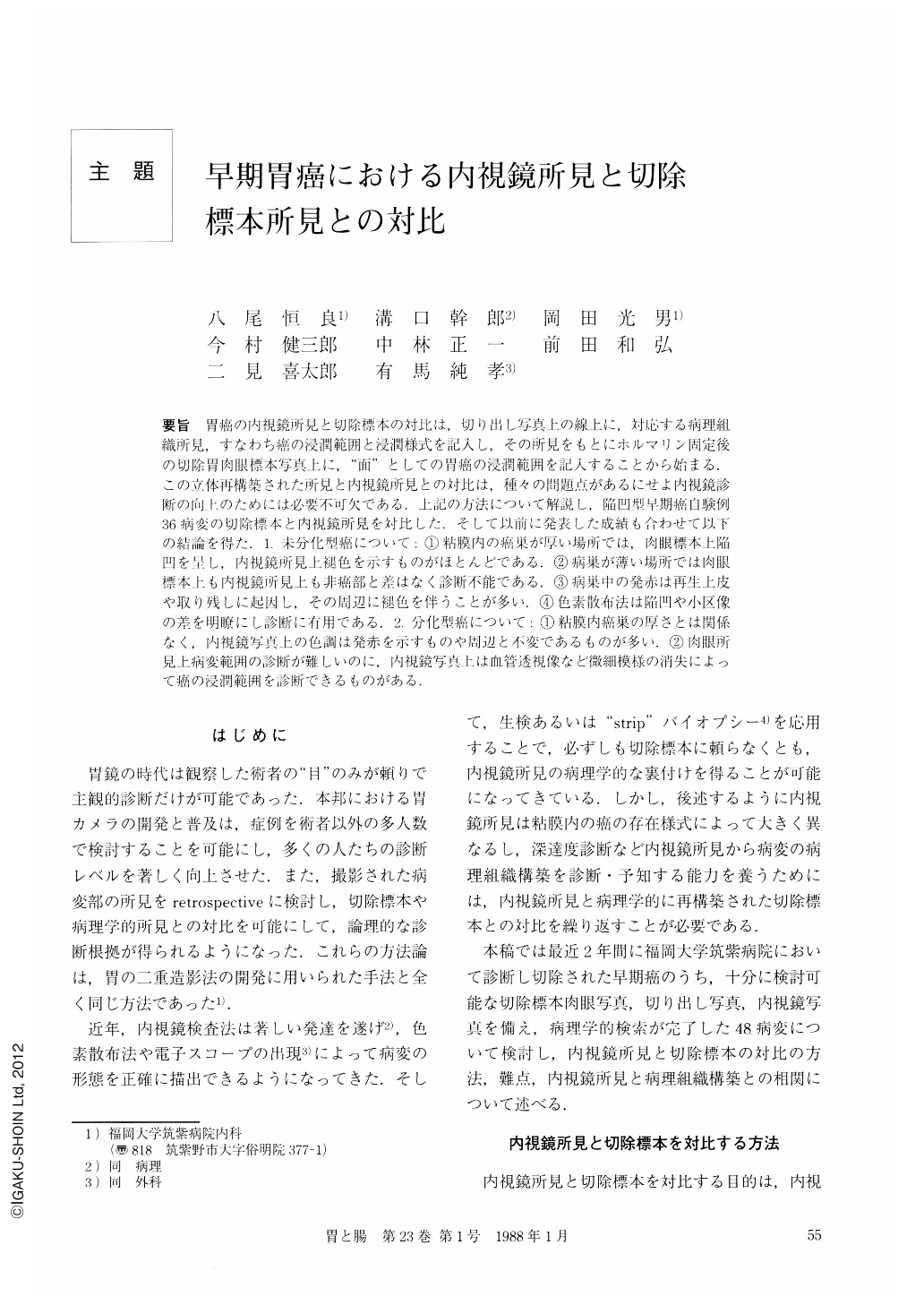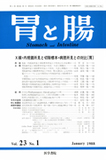Japanese
English
- 有料閲覧
- Abstract 文献概要
- 1ページ目 Look Inside
- サイト内被引用 Cited by
要旨 胃癌の内視鏡所見と切除標本の対比は,切り出し写真上の線上に,対応する病理組織所見,すなわち癌の浸潤範囲と浸潤様式を記入し,その所見をもとにホルマリン固定後の切除胃肉眼標本写真上に,“面”としての胃癌の浸潤範囲を記人することから始まる.この立体再構築された所見と内視鏡所見との対比は,種々の問題点があるにせよ内視鏡診断の向上のためには必要不可欠である.上記の方法について解説し,陥凹型早期癌自験例36病変の切除標本と内視鏡所見を対比した.そして以前に発表した成績も合わせて以下の結論を得た.1.未分化型癌について:①粘膜内の癌巣が厚い場所では,肉眼標本上陥凹を呈し,内視鏡所見上褪色を示すものがほとんどである.②病巣が薄い場所では肉眼標本上も内視鏡所見上も非癌部と差はなく診断不能である.③病巣中の発赤は再生上皮や取り残しに起因し,その周辺に褪色を伴うことが多い.④色素散布法は陥凹や小区像の差を明瞭にし診断に有用である.2.分化型癌について:①粘膜内癌巣の厚さとは関係なく,内視鏡写真上の色調は発赤を示すものや周辺と不変であるものが多い.②肉眼所見上病変範囲の診断が難しいのに,内視鏡写真上は血管透視像など微細模様の消失によって癌の浸潤範囲を診断できるものがある.
Comparative study of endoscopic findings and histopathological results of gastric cancer begins with a plane delineation of the extent of the lesion on a photograph of a resected specimen after formalin fixation based on pathological study of recording corresponding findings such as the extent of the lesion and the fashion of cancerous invasion on a gross macroscopic photograph after sectioning. The comparison of those pathologically reconstructed findings in three dimensions and endoscopic findings seems indispensable for a progress of the diagnostics of endoscopy.
Description of the methodology mentioned above was made, and comparative study of endoscopic and histopathological findings was performed on 36 cases with depressed type of early gastric cancer. Together with the results already reported, a conclusion as follows was obtained.
1. On undifferentiated type of cancer
(1) The mucosa with thick cancerous infiltration is depressed macroscopically, and reveals faded color on endoscopy in most cases.
(2) On the area with thin cancerous infiltration distinctio, n of cancerous and noncancerous region is hardly possible both macroscopically and endoscopically.
(3) Reddening in the lesion is caused by regenerative epithelia and island among cancerous infiltration, and it often accompanies with faded color in the surrounding area.
(4) Dye-spraying method facilitates the recognition of depression and the discrimination of changes in area gastricae, and this method is very helpful for the endoscopic diagnosis.
2. On differentiated type of cancer
(1) The lesion often revealed reddening or no change in color as compared with the surrounding mucosa, and those had no correlation with the thickness of intramucosal cancerous infiltration.
(2) There are some cases in which the diagnosis of the extent of the lesion is possible on endoscopy by recognition of disappearance of fine mucosal pattern such as that of vascular network pattern, whereas the determination on resected specimen is difficult.

Copyright © 1988, Igaku-Shoin Ltd. All rights reserved.


